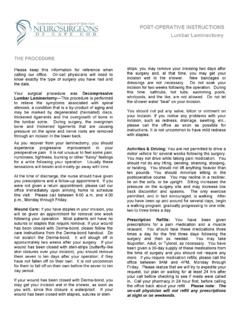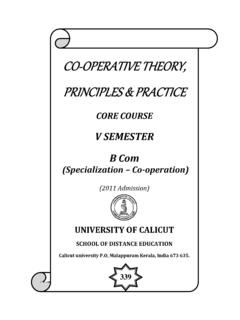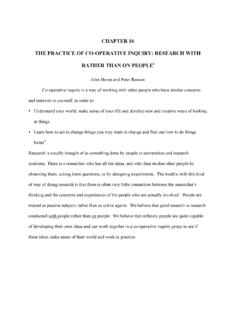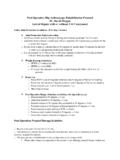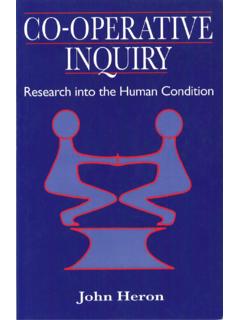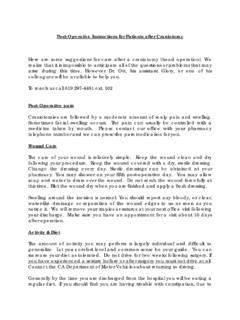Transcription of POST-OPERATIVE INSTRUCTIONS Lumbar …
1 POST-OPERATIVE INSTRUCTIONS Lumbar diskectomy THE PROCEDURE Please keep this information for reference when calling our office. On-call physicians will need to know exactly the type of surgery you have had, and the date. Your follow-up appointment is scheduled for 6 weeks after your surgery. Your surgical procedure is Microscopic Lumbar Discectomy - This procedure is intended to relieve pressure on the nerve roots that result from a disc rupture (herniation). During the procedure, the surgeon removes extruded fragments of the disc through an incision in the lower back.
2 The disc is a rubbery mass of tissue that acts as a natural shock absorber between the bones of the spine. As you recover from your surgery, you should experience progressive improvement in your preoperative pain. It is not unusual to feel some pain, numbness, tightness, burning or other "funny" feelings for a while following your operation. Usually these sensations will lessen and mostly go away with time. Numbness can last for weeks to months. At the time of discharge, the hospital nurse should give you prescriptions and a follow-up appointment. If you were not given a return appointment, please call our office upon arriving home to schedule this visit.
3 Please call between 9:00 and 4:00 , Monday through Friday. Wound Care: If you have staples or sutures in your incision, you will be given an appointment for removal one week following your operation. Most patients will have no sutures or staples that require removal. If your wound has been closed with Derma-bond, please follow the care INSTRUCTIONS from the Derma-bond handout. Do not scratch the Derma-bond. It will begin to slough off 7-10 days after your surgery. At this time you may use a warm wet washcloth to rub the rest of it off. If your wound has been closed with steri-strips (butterfly-like skin closures over your incision), you should remove them 7-10 days after your operation, if they have not fallen off on their own.
4 If your wound has been closed with Derma-bond, you may get your incision wet in the shower, as soon as you wish, since this closure is waterproof. If your wound has been closed with staples, sutures or steri-strips, you may remove your dressing two days after the surgery and, at that time, you may get your incision wet in the shower. New bandages or dressings are not necessary. Use only soap and water to gently clean the area around your wound. Do not soak your incision for four weeks following the operation. During this time, bathtubs, hot tubs, swimming pools, whirlpools, and the like, are not allowed.
5 Do not let the shower water "beat" on your incision. You should not put any salve, lotion, ointment or Vitamin E on your incision during the first month after surgery. If you notice any problems with your incision, such as severe redness, drainage, swelling, etc., please call the office as soon as possible for INSTRUCTIONS . It is not uncommon to have mild redness with staples. Activities & Driving: You are not permitted to drive a motor vehicle for several weeks following the surgery. You may not drive while taking pain medication. You should not do any lifting, bending, straining, stooping, or twisting.
6 You should not lift anything heavier than ten pounds. You should minimize sitting in the postoperative course. You may recline in a recliner, lie on the sofa, or be upright. Sitting increases the pressure on the surgery site and may increase low back discomfort and spasms. Sitting also increases the risk of recurrent disk rupture. The only exercise permitted, and in fact encouraged, is walking. After you have been up and around for several days, begin a walking program, gradually progressing to one mile, two to three times a day. When you return for your first postoperative visit (1 month), I will give you more exercises to do.
7 Prescription Refills: You have been given several medications. One is a pain medication, which you may take regularly for the first few days following the surgery, and then as needed. You may have been given Flexeril, which helps relieve muscle spasms. You should take this medication three times a day for the first three days following the surgery and then as needed. You may take Ibuprofen, Advil, or Tylenol, as necessary. You have been given a 30-day supply of these medications from the time of surgery and you should not require any more. If you require medication refills, please call the office between 9AM POST-OPERATIVE INSTRUCTIONS Lumbar diskectomy and 5PM, Monday through Friday.
8 We will do our best to expedite your request, but please allow 24 hours for us to process your refills. Please note: The on-call physician will not refill prescriptions at night or on weekends. Out of Work: You can expect to be out of work for a minimum of three to six weeks following your operation, depending on your healing progress and type of work you do. We want your surgical experience to go smoothly. If you have any questions or problems, please do not hesitate to call the office at You may find the following websites to be helpful regarding your surgery: , , , Thank you for allowing me to take part in your care, Achilles Papavasiliou, MD Paul Houle, MD Patrick Murray, MD G.
9 Kenji Nakata, MD
